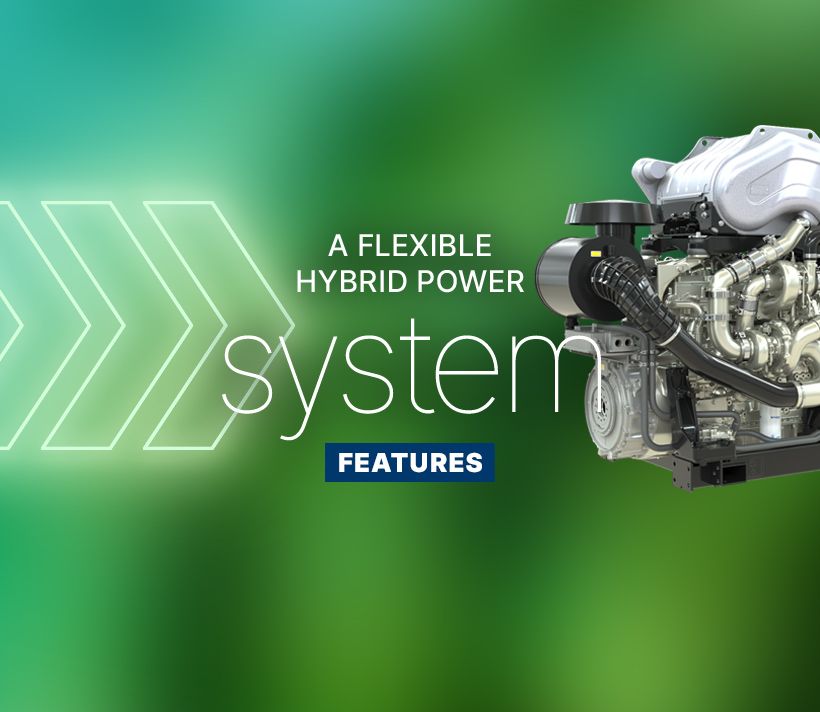One alternative fuel option we’ve researched heavily and have accommodated in our diesel engines for more than a decade is hydrotreated vegetable oil (HVO) – which must meet the EN 5940 standard – with the Perkins® 400 to 5000 Series able to use up to 100% HVO.
HVO is a renewable drop-in alternative to diesel. Common feedstocks for HVO include waste cooking oils and virgin plant oils such as soy, rapeseed, and palm. Produced through a process called hydrotreating, oxygen and other impurities are removed from the feedstock, resulting in a high-quality paraffinic hydrocarbon chemically similar to traditional diesel.
Since the hydrocarbon structure of HVO and diesel are similar, the two fuels exhibit comparable combustion behaviour, performance, and fuel efficiency when used in a diesel engine. Due to these similarities, HVO is sometimes referred to as renewable diesel and can be used as a drop-in replacement fuel, meaning no modifications are required to an existing diesel engine to use HVO.
Due to the consistency and chemical stability of HVO, it is resistant to a variety of factors such as oxidation and microbial growth, making it suitable for long-term storage without degradation.
Using HVO can significantly lower life cycle emissions from well-to-wheel for multiple reasons. First, HVO can be produced locally from available feedstocks, leading to a reduction in the emissions associated with the transportation of raw materials and the fuel itself.
The feedstocks for HVO are also derived from biological sources that absorbed CO2 as they were grown. Therefore, when HVO is burned as a fuel and CO2 is released back into the atmosphere, the majority of these emissions can be accounted for with the CO2 absorbed during the feedstock’s growth, resulting in a closed carbon loop. Or, if the feedstock comes from organic waste materials, less materials are potentially transported to landfills.
Since HVO has a higher heating value per unit of mass, each gram of HVO can produce more energy than the same mass of diesel, making HVO a highly energy-efficient fuel option, even if the engine consumes slightly more HVO by volume. This is because the high energy content of HVO compensates for the lower density.
One of the biggest challenges with the adoption of HVO today is the cost and availability of HVO, which tends to be more expensive and has limited availability in some regions. However, this is quickly changing as the sale of HVO is becoming more common in Europe and North America through fuel distributors, online fuel suppliers, and some fuel stations.
Lubricity, which is the ability of a fuel to minimise wear between moving metal parts in a fuel injection system, is a key concern from a fuel component perspective. Since HVO is highly refined and almost entirely paraffinic, it’s lubricity is not as good as the lubricity of a standard diesel. However, HVO fuels that meet the EN15940 standard are required to have lubricity additives, which means this is not an issue for EN15940 HVO fuels.
Last year, our engineers worked on a project in cooperation with Jubaili Bros, an OEM using Perkins engines in their diesel generator sets, to research the impacts on performance and emissions when using HVO for a generator set running a Perkins® 1103 Series engine. The testing was completed at Perkins’ Peterborough, UK facility between January and July 2024. The goals of this project were to:
Speaking to Powernews, Paul Muller, Perkins technical sales manager explained: “Today we've been looking at the generator set we've had on test here at Perkins which has been running on HVO.
“We've been doing some testing to see what the effect is on the generator set and to find out whether there are any changes needed to the set, any changes needed in maintenance and what happens to the emissions during the running of the generator set itself.
“In cooperation with Jubaili Bros, with who we’ve worked for over 45 years, their generator sets were the perfect application for us to undertake this testing. By using a product that uses our engine today also meant we could repeatedly run the test and take those emissions measurements, but also by using a load bag, repeatedly look at the load acceptance.
“The set's been running on HVO. During that testing we've taken various measurements during the operation, at 0 hours, 50 hours, 500 hours and then at 1,000 hours. At each of those points we've been measuring the fuel consumption, measuring the load acceptance and also the exhaust emissions that come out of the tailpipe.”
“Through that testing that we found there's actually very little difference between the HVO and regular diesel in terms of the engine’s operation,” continued Paul. “There's no changes in the maintenance. The filter service intervals are exactly the same. The oil life looks really good on it.
“What we have found is that the hydrocarbons are a little lower with the fuel that we were testing, but generally the exhaust emissions were the same. The other small difference to be found was the fuel consumption was a little bit higher and this is mainly due down to the difference in density of the fuel. The density of HVO is a little bit lower fossil diesel, but the HVO has a slightly higher energy value within it, so that offsets some of that fuel consumption difference and then brings it to be pretty close. We were seeing a less than three percent difference in the fuel consumption between regular diesel and HVO.
“When you run the engine, when you run the generator cell itself, the actual CO and CO2 coming out of the tailpipe is broadly the same as with fossil-based diesel fuels. But where the difference really comes from is the overall life cycle. The feedstocks that go into making the HVO in the first place, most of them are either vegetable based or could be used cooking oil.
“The vegetation, when it's grown, it's sucking CO2 out the air, absorbing CO2 when you then process the fuel and then burn it in the engine, you are releasing that CO2. But overall, through the whole life cycle, we do see a significant reduction in the total CO2 content.”
The tests on the generator set showed that HVO is a one-to-one replacement for diesel, both in a pure fashion and in a blended form.
Paul added: “There's no cleaning of tanks needed, no filters needed changing ahead of moving back to HVO. So, it makes it flexible and really allows the customers to have peace of mind that they can keep running and not have to worry about things if there is a lack in supply and a gap in being able to source the fuel.”
“This HVO testing is part of our overall strategy to see how we can support our customers during the evolving energy landscape,” added Paul.
“This is just one aspect. HVO is a really good fuel for a lot of our customers, being drop in, being able to be used in their current machinery or vehicles or generator sets as in this case with the Jubaili Bros generator set.”
Want to find out more? Perkins has developed a white paper on: ‘Unlocking Flexibility in Fuel Choices: A Detailed Comparison of HVO and Diesel’ which goes into more detail on fuels, the tests undertaken and the findings. Access the white paper here.
Perkins’ collaboration with Trackunit, delivering real-time insights to customers, increasing productivity in the field.
Read moreFor industrial equipment rental, excellent technical support and parts availability is a necessity.
Read moreTo mark Agritechnica's 'Celebrate Farming Day', Powernews spoke to Andy Curtis, Customer Solutions Director at Perkins.
Read moreClever configuration options fulfil the current and future requirements of the industry.
Read moreWho keeps the lights on when the grid can’t? The power generation sector, of course. In the UK, its interests are represented by The Association of Manufacturers and suppliers of Power generating Systems (AMPS) – whose new director general, Alan Beech, came into post earlier this year.
Learn MoreHave you ever looked at the name of a Perkins engine and wondered what all those numbers and letters actually mean? If so, you’re certainly not alone. But rest assured the nomenclature is anything but random.
Read moreIn part two of our spotlight on marine we talk with Ben Lewis commercial manager, Dave Wood, application and tech support team lead and Stuart Phillipson, marine application and tech support to find out more about what’s in development for the marine range.
Read moreWhy stick to one fuel, when you can have a configurable power system?
Read moreMore than just a curiosity, they offer us different routes to future food security.
Read morePerkins marine engines has an illustrious history. Meet the team behind the brand.
Read moreHave you ever looked at the name of a Perkins engine and wondered what all those numbers and letters actually mean? If so, you’re certainly not alone. But rest assured the nomenclature is anything but random.
Read moreWho keeps the lights on when the grid can’t? The power generation sector, of course. In the UK, its interests are represented by The Association of Manufacturers and suppliers of Power generating Systems (AMPS) – whose new director general, Alan Beech, came into post earlier this year.
Learn MoreIn part two of our spotlight on marine we talk with Ben Lewis commercial manager, Dave Wood, application and tech support team lead and Stuart Phillipson, marine application and tech support to find out more about what’s in development for the marine range.
Read more













